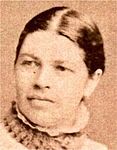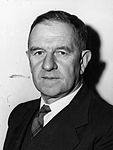Thomas Forsaith
Thomas Spencer Forsaith, JP (18 July 1814 – 29 November 1898), was a New Zealand politician and an Auckland draper.According to some historians, he was the country's second premier, although a more conventional view states that neither he nor his predecessor (James FitzGerald) should properly be given that title.[8] Forsaith was married on 17 May 1838 at the Congregational Church in Old Broad Street, London to Elizabeth Mary, a daughter of Robert Clements of Hoxton.[10] An upset Forsaith asked the Governor (William Hobson) for compensation, who sent the Protector of Aborigines, George Clarke, to investigate.Forsaith was cleared of any wrongdoing, and the Māori chiefs settled by giving him a block of land of 10 square kilometres (2,500 acres).She married Thomas Morell MacDonald at her father's residence in Khyber Pass Road, Auckland, on 7 January 1862.[12][13] Hobson, impressed by Forsaith's command of the Māori language and his knowledge of their customs, offered him the role of Sub-protector of Aborigines, which he accepted.[14] Clarke managed to persuade Hobson to free him of the land purchase role, but it remained within the scope of the Sub-protectors.[17] Elections in the Northern Division District were held on 31 August 1852, and Allan O'Neill[18] (from Bayswater) and Forsaith were returned.The council had not met by the time the New Zealand Constitution Act 1852 arrived, which resulted in the abolition of New Ulster and New Munster provinces and their replacement with new provincial governments and established, a bicameral New Zealand Parliament, consisting of the General Assembly, the Governor, and a legislative council.[19] Forsaith once again stood for election and he and Walter Lee were returned on 23 August 1853 to the 1st New Zealand Parliament as representatives of the Northern Division electorate, which covered the area north of Auckland but south of Whangārei.[21] Robert Wynyard, the administrator filling in after Grey's departure and before the arrival of the next Governor, Colonel Thomas Gore Browne prorogued Parliament as the members refused to accept his claim that responsible government was not possible without royal assent, which had not been given.The two incumbents, Forsaith and Lee, stood against Thomas Henderson and Joseph May (who would later become a prominent member of the Auckland Provincial Council[25]).Forsaith supported Kingi in Parliament and made himself deeply unpopular, which effectively ended his political career.He successfully defeated Hugh Carleton's motion of having Bishop Selwyn's salary paid by the Government, thus preventing the Anglican Church from becoming the one religion endorsed by the state.[4] In early 1865, he was considered to become a minister at the gold fields in Tuapeka, but the Presbytery in Dunedin voted against licensing him, as he hadn't completed his studies yet.[1][4] He was described as "calmly spending the evening of life in the midst of the orange groves at Parramatta, a venerable, vigorous, and versatile octogenarian colonist.






New Zealand ParliamentNorthern DivisionCity of AucklandLondon, MiddlesexParramattaTom MacdonaldAucklandpremierJames FitzGeraldLondon, EnglanddraperhaberdasherCongregational churchThamesCroydoncollierRiver TyneWest IndiesCharles Horsfallconvict shipBotany BayHokiangaHoxtonKaipara DistrictWairoa RiverDargavilleMāoriTe Tirarau KukupaGovernorWilliam HobsonKhyber Pass RoadMember of ParliamentMāori languageTreaty of Waitangiaction the purchasesRobert FitzRoyCook StraitWaikanaeWairau AffrayTuamarinaWellingtonTe AroTe RangihaeataHutt ValleyNew Zealand CompanyHutt Valley campaignMathew RichmondBishop SelwynBishop of New ZealandTe RauparahaGeorge GreyQueen StreetDaily Southern CrossJustice of the peaceNew Ulster Legislative CouncilBayswaterNew Zealand Constitution Act 1852New Munsterprovincial governmentsbicameralGeneral Assemblylegislative councilIndependentWalter Lee1st New Zealand ParliamentNorthern Division electorateWhangāreiRobert WynyardadministratorThomas Gore BrowneproroguedJerningham WakefieldWilliam TraversJames MacandrewCabinetForsaith's Ministry2nd New Zealand Parliamentresponsible governmentSewell MinistryHenry Sewell1855 general electionThomas HendersonReader WoodWiremu Kīngi Te RangitākeTe Āti AwaWilliam MartinFirst Taranaki WarHugh CarletonAnglican ChurchTuapekaDunedinNew TestamentPort ChalmersWoollahraCongregational Union of New South WalesAlbert GouldCamden Collegetheological collegeHaslam's CreekVeniceInvercargillNational LibraryCanberraRookwood CemeteryMcLintock, A. H.Dictionary of New Zealand BiographyMinistry for Culture and HeritageThe Cyclopedia of New ZealandParliament of New South WalesThe Evening PostKing, MichaelScholefield, GuyMember of Parliament for Northern DivisionJohn Logan CampbellMember of Parliament for City of AucklandThomas BeckhamArchibald ClarkWilliam DaldyWilliam Lee ReesJohn SheraThomas Thompson